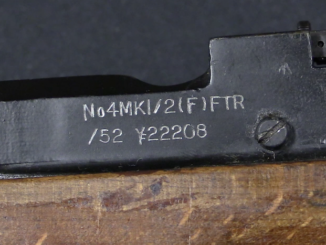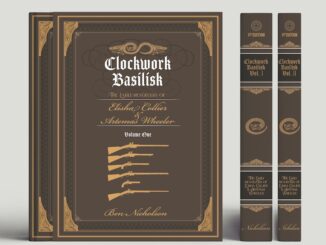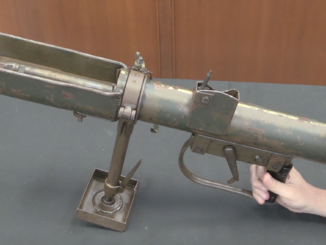The Kickstarter for my new book, “Pistols of the Warlords” is live here!
William E. Fairbairn is best know for his work with Eric Sykes and their “”Commando” knife design during World War Two. However, Fairbairn spent some 33 years in the Shanghai Municipal Police, working his way up from a beat constable to Assistant Commissioner. There he was responsible for the SMPD adopting truly forward-thinking fighting methods, and he essentially invented the modern SWAT team (the “Reserve Unit”, which Fairbairn led for 10 years). He combined expertise in formal marksmanship, instinctive practical shooting, and hand-to-hand combat schools (including jiu-jitsu and judo) into a comprehensive training program like no other on earth at the time.
Book references:




As you’ve mentioned, Leroy Thompson’s book on the subject is great. I got mine to read on Kindle.
Wow. Headstamp needs to investigate the US rights to the Robbins book. Price on Amazon tripled between when you created the link and when I clicked on it. Going to have to investigate some lesser known used book outlets.
Had the great fortune to meet the late Rex Applegate during his tenure as an NRA board member, and in my brief conversation w/ him, completely confused him w/ William Fairbairn – and asked COL Applegate about his time in the Shanghai Police. Hopefully he was amused.
Fairburn and Sykes book “Shooting to Live” is one of the earliest references I can find in print to shooting a handgun with two hands. I suspect it was done earlier than the 1930’s but as far as I can find no printed anything about two handed shooting prior to the mid 30’s.
Great video. Like many others I shall have to get the books.
Looking at the other videos you’ve done on the Shanghai 1908 Colt, I suspect the spring is there to force the barrel to a consistent position for each shot to help maintain accuracy despite extensive wear.
No way to tell today if the barrel bushing was lapped larger to loosen it up to provide better immunity to dirt. Absent period documentation I’d assume it’s simply to compensate for wear that in other contexts would have been addressed by a major overhaul or a new pistol.
Dad was in Shanghai in 1945 in the Navy. He remarked that the carts went around every morning to pick up the corpses from the night before.
Don’t quite remember my source on this (probably in the comments section of the FW video on the Shangahi ’08 Colt), but the spring was to force the barrel slightly toward the extractor. The original Colt extractor as designed worked fine on UMC or other US cartridges, but the Shanghai police were sourcing their .380 ammo from Kynoch in Britain, who cut the extraction grooves a little narrower or shallower or both. Ian Hogg, in his book on artillery, quotes the maxim, “If something’s wrong with your gun, better change the ammo.” Obverse is true if you can’t change your source of ammo.
Fairbairn also designed and built a sort of ‘westernized’ kukri. Called the ‘smatchet.’
I’ll add another plug for ‘Shooting to Live with the One Hand Gun.’ I think you can still find pdf versions online. Lots about organizing shooting courses, maintaining issue guns and magazines, rotating ammunition supplies to avoid shelf-wear etc. Also advice against civilian self-defense with pistols, he thought an exposed-hammer double barreled shotgun was a safer and better bet.
Shanghai police disabled the grip safeties on the 1908s and 1911 pistols they issued. There’s also a discussion about the notion of ‘stopping power’ including an anecdote about a Sikh policeman who ‘won’ a running gunfight with a Chinese gangster by slugging him with his emptied .455 Webley. Only to find that he’d actually hit the guy several times with no discernable effect.
I beg to differ. It was the manual safeties that were disabled, and the grip safeties, so far as I know, left alone. Pistols were carried with the chamber empty and officers were taught to draw and rack the slide in one movement.
In “Shooting to Live” there is another anecdote of an English or American officer who hit his target with six or seven rounds from a .45 Colt automatic and then had to beat the criminal unconscious. Fairbarn was skeptical about the whole idea of “stopping power” and stated that 7.63 Mauser was the truly feared cartridge, because even non-fatal wounds led to permanent injury.
(Checking my copy) Two anecdotes in adjacent paragraphs. On page 73:
‘On this occasion, a Sikh constable fired six shots with his .455 Webley at an armed criminal of whom he was in pursuit, registering five hits. The criminal continued to run and so did the Sikh, the later clinching the matter finally by battering in the back of the criminal’s head with the butt of his revolver…’
On page 74:
A ‘European Officer’ hits a stick-up man six times with a .45 Colt. ‘Yet, in spite of all this, the robber was still on his feet and was knocked unconscious by the butt of the sergeant’s pistol…’
Mauser story on page 75.
Not sure how I mixed up the pinning of grip safeties with the immobilizing of the thumb catch that Ian shows on the 1908 .380 in the 2018 vid.
Why don’t you and some of the other knowledgeable authors collaborate in writing a semi-historical screen play of Fairbairn’s life. Indeed a fascinating warrior whose exploits would make a great movie.
Three production have expressed interest and one is negotiating currently to do a film based on THE WORLD’S FIRST SWAT TEAM